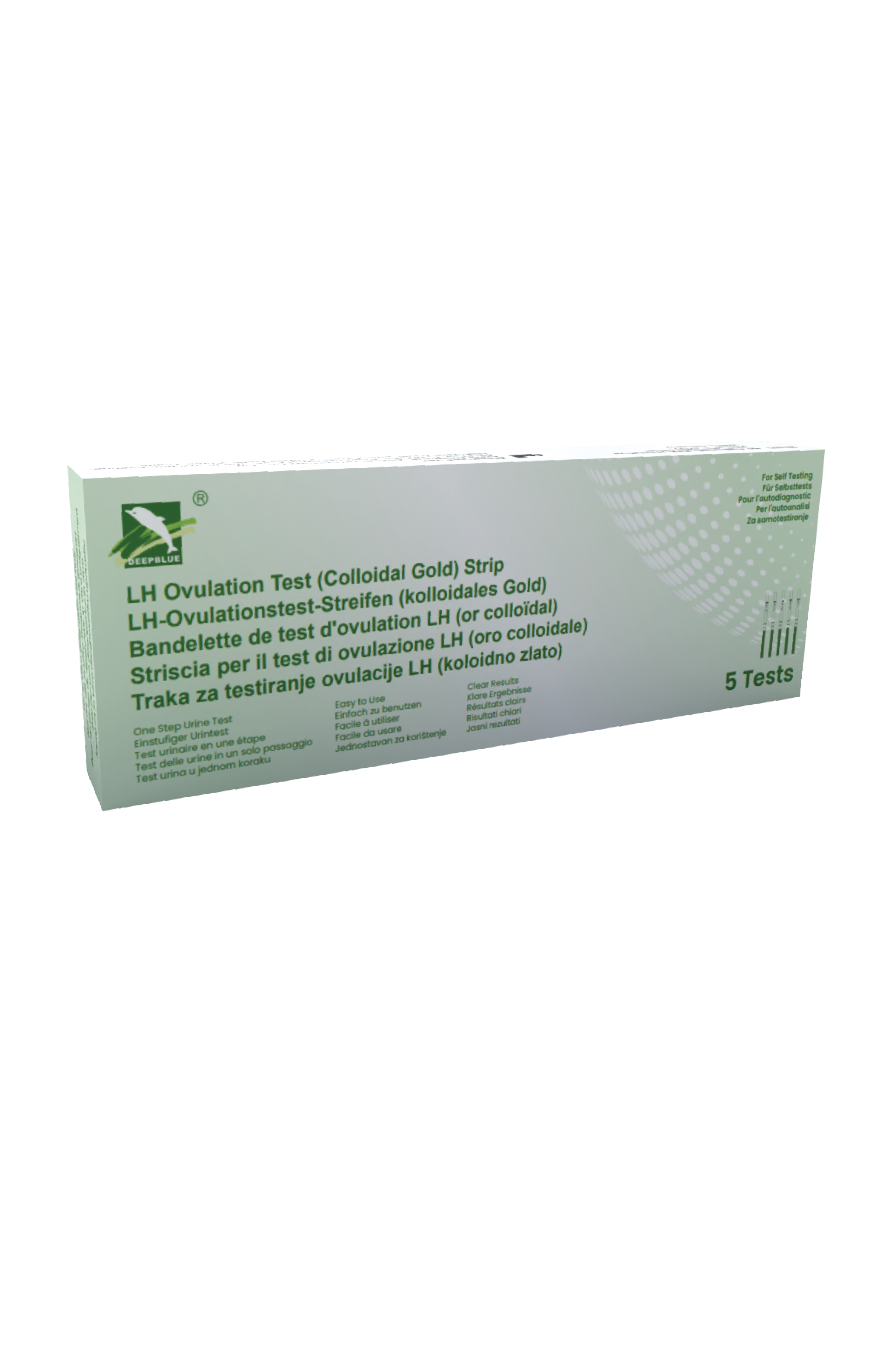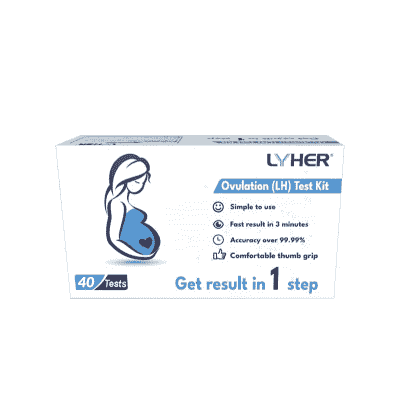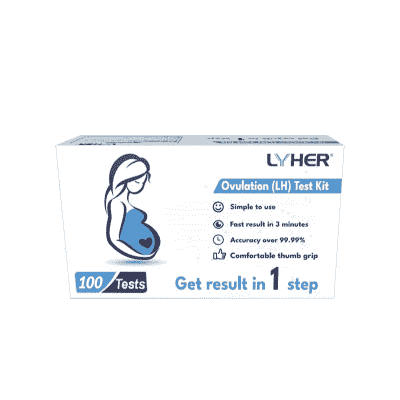Buy Ovulation Tests
With our ovulation tests at OdemShop, you can determine your most fertile days. They are easy to use and provide accurate results to maximize your chances of pregnancy.
How can I use ovulation tests to boost my chances of conceiving a child?
Ovulation tests play an important role for women planning pregnancy. They make it possible to determine the time of ovulation and thus increase the chances of successful conception. Although there are many methods to determine ovulation, an ovulation test is a quick and straightforward way to detect the fertile days.
In this article, we will provide you with all the important information about ovulation tests and how they work so that you can make the best choice possible.
What is an ovulation test?
An ovulation test, also known as an LH test, is a tool that women can use to determine the ideal time in their cycle for fertility. This test measures the concentration of luteinizing hormone (LH) in the urine. LH plays a crucial role in the female cycle because its increase triggers ovulation, the release of an egg from the ovary.
There are several types of ovulation tests, including classic ovulation tests and digital ovulation tests. Most tests use the same method: they analyze a sample of collected urine at approximately the same time on several consecutive days. A rise in the LH level, often indicated by a darker color of the colored stripe, indicates that ovulation is imminent.
A positive ovulation test usually means that ovulation will occur within the next 12-24 hours, which is considered a time of high fertility. This is the optimal time for unprotected intercourse if pregnancy is desired. If the ovulation test is negative, the test should be repeated in the next few days.
It is important to note that ovulation tests should not be used as the sole means of contraception. They can only predict the most likely time of ovulation, but cannot prevent it. Also, factors such as irregular cycles or the use of certain medications can affect the accuracy of the test.
Digital tests, such as a fertility monitor with pregnancy test function, can additionally detect other hormones in the urine, allowing for a more accurate prediction. Regardless of which option you choose, you should always follow the detailed instructions provided by the provider when using ovulation tests.
In summary, ovulation tests can be a useful tool for women who want to better understand and control their cycle and fertility. They can help determine the optimal time for possible conception, but should always be used in combination with other methods and in consideration of the individual hormonal cycle.
How does an ovulation test work?
For example: Sarah was having trouble getting pregnant and decided to use an ovulation test. With an ovulation test, Sarah could measure the luteinizing hormone in her urine and determine if her body was ready for conception.
After recording several ovulation-positive days, Sarah was overjoyed when the ovulation test indicated positive - the time had finally come!
Ovulation tests allow pregnant women to have the best possible chance by identifying when the egg is most fertile. They help women understand exactly when she is ready to conceive and when is the best time to try to get pregnant. In this way, couples can specifically try to conceive and significantly increase their chances.
Now that we know how ovulation tests work, the question of the right time to use them naturally arises...
At what point in the menstrual cycle can an ovulation test be employed?
Now that we understand how an ovulation test works, we can move on to the question of when to use it.
In order to determine the best time to conceive, an ovulation test can be performed. This test measures the increase in luteinizing hormone (LH), which is released just before ovulation. It is best to perform the test in the morning, as LH is highest in the early morning hours. A positive test result indicates that ovulation will occur within the next 24-48 hours.... It is important to note that the length of the menstrual cycle varies from woman to woman and therefore the timing of ovulation also varies. It is recommended to perform the test on several consecutive days to determine the optimal time.
What factors should I consider when selecting the most suitable ovulation test for me?
Below you will find key points that will help you make your choice:
- Experience with the product: when it comes to choosing an ovulation product, it is important to look for customer experiences about different providers.
- Price comparisons: Compare different ovulation products based on price and quality, as well as reviews from other users.
- Safety aspect: when deciding on an ovulation test, always look at the safety of the product and make sure it has no side effects.
- Trusted provider: Look for a trusted provider of ovulation products so that you can be sure that you will be provided with high quality products.
- Customer service: the provider's customer service should work well and be easy to reach - in case any questions or problems arise.
We have now seen what you need to look for to find the right ovulation test for you. As a next step, let's take a closer look at how to use it.
What are the steps involved in utilizing an ovulation test?
It is important to understand the ovulation cycle when trying to get pregnant. Therefore, let's take a look at what the ovulation cycle is and how to apply an ovulation test.
Understanding the ovulation cycle
To understand the ovulation cycle, it is important to know that it consists of different phases. The menstrual cycle begins on the first day of your period and usually lasts about 28 days. In the first phase, the menstrual phase, the lining of the uterus is broken down. The following follicular phase is triggered by hormones that mature the follicle in the ovaries. The climax of the cycle is ovulation, when an egg is released from the follicle. This is followed by the luteal phase, during which hormones prepare the uterine lining for a possible pregnancy. If fertilization does not occur, the mucosa breaks down and the next menstrual phase begins. Understanding the ovulation cycle can help determine the best time to conceive.
Use ovulation tests
Now that you understand your cycle better, you can safely use the ovulation test.
To use an ovulation test, it is important to know that it measures the increase of luteinizing hormone (LH) in the urine, which is released before ovulation. It is recommended to perform the test in the morning, as LH is highest in the early morning hours. The test strip is simply dipped into the urine and after a short waiting period the result is displayed. A positive result of the test indicates that ovulation will occur within the next 24-48 hours. It is important to perform the test on several consecutive days to determine the optimal time. It is also advisable to follow the manufacturer's instructions carefully to obtain an accurate result.
How is an ovulation test evaluated?
After you have performed the ovulation test it is time to interpret the results. This can be difficult, but with the right knowledge and careful consideration of your data, you can figure out when you are most fertile.
For example: a positive result usually means that your body is currently in its ovulatory phase and the chances of pregnancy are high.
Negative results can also be useful; they help you determine the more ideal day for intercourse.
With a little patience and tact, ovulation test results can help you get pregnant!
Alternatives to ovulation tests
It's easy to understand why an ovulation test can help in achieving the goal of pregnancy. But what happens if you get a negative ovulation test? Are there other options for people with irregular cycles or hormonal problems?
There are actually alternatives to using ovulation tests. For women with irregular cycles or limitations in the female cycle, ultracentric follicle measurement is available as a way to determine the optimal time for fertilization. This method consists of measuring human chorionic gonadotropin levels before ovulation and after ovulation. The peak of these readings indicates when the most fertile days are. Although this method can be a bit more expensive than simple ovulation tests, it provides more accuracy and certainty regarding the optimal period of fertilization.
We now look at LH (luteinizing hormone) to find out more about the biological optimization possibilities in terms of pregnancy success...
What is LH?
The test measures the hormonal level of luteinizing hormone (LH), which occurs in the middle phase of the female cycle and indicates the maturation of the egg.
LH increases sharply the day before ovulation and this can be measured by an ovulation test. It therefore gives an indication of the time of the fertile period, which makes it easier to get pregnant. The ovulation test thus offers women an effective way of finding out whether they are currently fertile or not. Due to its accuracy, it has become a popular means of contraception and has helped couples with an unfulfilled desire to have children to finally make their dreams come true.
It is therefore no surprise that more and more people are using ovulation tests! With the right knowledge, you can soon reach your goal - enjoying parenthood - without much effort!
What are possible problems that can be associated with ovulation?
Ovulation can occur irregularly or differently than expected, which can make it more difficult to determine the right time to ovulate. Often, a woman will not notice the signs and symptoms right away, or she may ignore them completely.
Ovulation tests help women more accurately determine the day they ovulate. They make it easier to find out when the body is most fertile. There are also special tests on the market that help those who are trying to get pregnant to better plan and understand if ovulation is actually occurring.
However, there are problems associated with this: Some tests do not give accurate results; some people use them incorrectly; false positives and false negatives could occur; some human hormones affect the accuracy of the tests, etc.
So it is very important to read the manufacturer's instructions carefully to get a direct result about ovulation from ovulation tests. Moreover, you should always do more than one test to make sure that the result is correct and health risks are minimized.
Conclusion
In conclusion, we can say that ovulation tests can be a useful tool for couples who want to get pregnant. They help predict ovulation and can be used in combination with other fertility tests. However, they should be used with caution, as misinterpretation can occur. Tests should always be used within the recommended period to obtain accurate results. Also, it is advisable to choose test strips that are fit for purpose - as if deciding on different types of tools.
The right test strip is like a hammer or screwdriver: it's necessary to get the job done and get the best results!
Related categories:
Where can I buy an ovulation test wholesale or in specialized stores?
You can buy ovulation tests in wholesalers, specialized stores, pharmacies, supermarkets and online. We recommend you to buy ovulation test in our online store, OdemShop, as we offer a selection of high quality products and ensure that you get an accurate and reliable result. Moreover, we offer easy and convenient ordering and delivery directly to your home. Trust OdemShop for your ovulation testing needs and experience the difference in quality and customer service.
FAQ's
What is an ovulation test?
An ovulation test is a test that measures the increase of luteinizing hormone (LH) in urine, which is released just before ovulation. The test is used to determine the optimal time for conception.
How does an ovulation test work?
An ovulation test measures the LH surge in the urine. The test strip is simply dipped into the urine and after a short waiting time the result is displayed.If an ovulation test yields a positive result, it indicates that ovulation is expected to take place within the following 24-48 hours.
How safe are ovulation tests?
Modern ovulation tests are very reliable, especially when used correctly. Most tests have an accuracy of over 99%.
When is the best time to perform an ovulation test?
The best time to perform an ovulation test is usually in the morning, as LH is highest in the early morning hours. The test should be performed on several consecutive days to determine the optimal time.
Can medications affect the result of an ovulation test?
Yes, certain medications such as fertility drugs or hormone supplements can affect the result of an ovulation test. It is advisable to consult your doctor if you are unsure whether taking medication can affect the result.
Can an ovulation test be false positive?
Yes, it is possible for an ovulation test to be false positive, meaning that it indicates that ovulation is imminent when it is not. This can occur due to medical conditions or the use of certain medications.
Can an ovulation test be false negative?
Yes, it is possible for an ovulation test to be false negative, meaning that it indicates that ovulation is not imminent when in fact it is imminent. This can occur due to an irregular cycle or an insufficient amount of LH in the urine.
Can you do an ovulation test more than once?
Yes, you can run an ovulation test multiple times to determine the optimal time to conceive.
What is the duration required for an ovulation test to generate outcomes?
Most ovulation tests provide results within a few minutes. However, some tests may take longer and may require you to check the result after a certain amount of time.
Can ovulation tests predict ovulation?
The answer is yes! Ovulation test strips measure the concentration of luteinizing hormone (LH) in your urine and help you find out if you are fertile. If you take ovulation-based tests regularly, they can help you time when you are most receptive to pregnancy.
Can ovulation tests lead to misinterpretation?
Yes, ovulation tests can lead to misinterpretation. This is because they only indicate when you are most fertile - unlike other fertility tests that also confirm ovulation. Therefore, when reading the results, it is important to speak with a doctor or specialist about possible diagnoses and treatment options to make an accurate determination of when you are ovulating.
How long are ovulation tests valid after opening?
If you're trying to get pregnant, it's important to know the shelf life of your ovulation tests. Once a test is opened, they are usually valid for 3-5 days - but especially with older tests, you should pay attention to the expiration date on the package. Therefore, it is recommended to use only fresh ovulation tests and to buy new tests regularly to be able to interpret the results correctly.
What type of test strip is best for ovulation testing?
According to a survey, 60% of women who tried to get pregnant were successful with urine test strips. A urine test strip can help determine if your body is producing luteinizing hormone (LH), which serves as an indicator of the onset of ovulation.These tests are non-invasive and therefore much more convenient than other methods. They are also relatively inexpensive and readily available in pharmacies or online. Therefore, urine test strips can be a good choice to find out when your body is ready to conceive.



